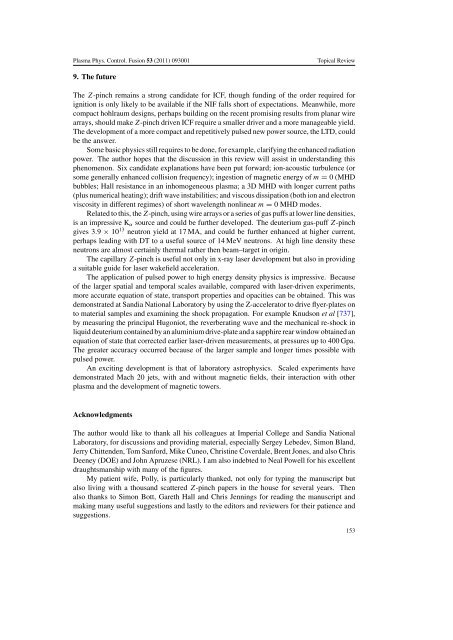Create successful ePaper yourself
Turn your PDF publications into a flip-book with our unique Google optimized e-Paper software.
Plasma Phys. Control. Fusion 53 (2011) 093001<br />
Topical Review<br />
9. The future<br />
The Z-<strong>pinch</strong> remains a strong candidate for ICF, though funding <strong>of</strong> <strong>the</strong> order required for<br />
ignition is only likely to be available if <strong>the</strong> NIF falls short <strong>of</strong> expectations. Meanwhile, more<br />
compact hohlraum designs, perhaps building on <strong>the</strong> recent promising results from planar wire<br />
arrays, should make Z-<strong>pinch</strong> driven ICF require a smaller driver and a more manageable yield.<br />
The development <strong>of</strong> a more compact and repetitively pulsed new power source, <strong>the</strong> LTD, could<br />
be <strong>the</strong> answer.<br />
Some basic physics still requires to be done, for example, clarifying <strong>the</strong> enhanced radiation<br />
power. The author hopes that <strong>the</strong> discussion in this <strong>review</strong> will assist in understanding this<br />
phenomenon. Six candidate explanations have been put forward; ion-acoustic turbulence (or<br />
some generally enhanced collision frequency); ingestion <strong>of</strong> magnetic energy <strong>of</strong> m = 0 (MHD<br />
bubbles; Hall resistance in an inhomogeneous plasma; a 3D MHD with longer current paths<br />
(plus numerical heating); drift wave instabilities; and viscous dissipation (both ion and electron<br />
viscosity in different regimes) <strong>of</strong> short wavelength nonlinear m = 0 MHD modes.<br />
Related to this, <strong>the</strong> Z-<strong>pinch</strong>, using wire arrays or a series <strong>of</strong> gas puffs at lower line densities,<br />
is an impressive K α source and could be fur<strong>the</strong>r developed. The deuterium gas-puff Z-<strong>pinch</strong><br />
gives 3.9 × 10 13 neutron yield at 17 MA, and could be fur<strong>the</strong>r enhanced at higher current,<br />
perhaps leading with DT to a useful source <strong>of</strong> 14 MeV neutrons. At high line density <strong>the</strong>se<br />
neutrons are almost certainly <strong>the</strong>rmal ra<strong>the</strong>r <strong>the</strong>n beam–target in origin.<br />
The capillary Z-<strong>pinch</strong> is useful not only in x-ray laser development but also in providing<br />
a suitable guide for laser wakefield acceleration.<br />
The application <strong>of</strong> pulsed power to high energy density physics is impressive. Because<br />
<strong>of</strong> <strong>the</strong> larger spatial and temporal scales available, compared with laser-driven experiments,<br />
more accurate equation <strong>of</strong> state, transport properties and opacities can be obtained. This was<br />
demonstrated at Sandia National Laboratory by using <strong>the</strong> Z-accelerator to drive flyer-plates on<br />
to material samples and examining <strong>the</strong> shock propagation. For example Knudson et al [737],<br />
by measuring <strong>the</strong> principal Hugoniot, <strong>the</strong> reverberating wave and <strong>the</strong> mechanical re-shock in<br />
liquid deuterium contained by an aluminium drive-plate and a sapphire rear window obtained an<br />
equation <strong>of</strong> state that corrected earlier laser-driven measurements, at pressures up to 400 Gpa.<br />
The greater accuracy occurred because <strong>of</strong> <strong>the</strong> larger sample and longer times possible with<br />
pulsed power.<br />
An exciting development is that <strong>of</strong> laboratory astrophysics. Scaled experiments have<br />
demonstrated Mach 20 jets, with and without magnetic fields, <strong>the</strong>ir interaction with o<strong>the</strong>r<br />
plasma and <strong>the</strong> development <strong>of</strong> magnetic towers.<br />
Acknowledgments<br />
The author would like to thank all his colleagues at Imperial College and Sandia National<br />
Laboratory, for discussions and providing material, especially Sergey Lebedev, Simon Bland,<br />
Jerry Chittenden, Tom Sanford, Mike Cuneo, Christine Coverdale, Brent Jones, and also Chris<br />
Deeney (DOE) and John Apruzese (NRL). I am also indebted to Neal Powell for his excellent<br />
draughtsmanship with many <strong>of</strong> <strong>the</strong> figures.<br />
My patient wife, Polly, is particularly thanked, not only for typing <strong>the</strong> manuscript but<br />
also living with a thousand scattered Z-<strong>pinch</strong> papers in <strong>the</strong> house for several years. Then<br />
also thanks to Simon Bott, Gareth Hall and Chris Jennings for reading <strong>the</strong> manuscript and<br />
making many useful suggestions and lastly to <strong>the</strong> editors and <strong>review</strong>ers for <strong>the</strong>ir patience and<br />
suggestions.<br />
153














